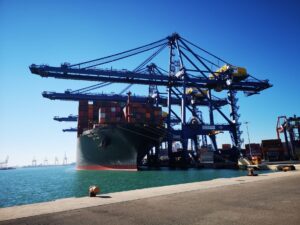
The Valencia Containerised Freight Index (VCFI) stands at 2,423 points, accumulating an increase since the beginning of the historical series in January 2018 of 142.3%.
The indicator that measures the trend and evolution of container transport costs by sea from the Port of Valencia has been falling for seven consecutive months.
The general trend has been a decrease in the level of freight rates in all the areas analysed by the VCFI, except in the Eastern and Western Mediterranean, with an increase of 9.76% and 5.89%, respectively.
The Valencia Containerised Freight Index (VCFI) again recorded a fall of -12.52% in March compared to the previous month, accumulating seven consecutive months in decline to stand at 2,423.01 points. The indicator that measures the trend and evolution of container transport costs by sea from the Port of Valencia accumulates a growth since the beginning of the historical series in January 2018 of 142.30%. The general trend has been a fall in the level of freight rates in all the areas analysed by the VCFI, especially in Central America and the Caribbean (-24.70%) and the Baltic States (-22.06%). On the other hand, in some areas the evolution of freight rates has been upward, such as in the Eastern and Western Mediterranean, with an increase of 9.76% and 5.89%, respectively.
As regards the evolution of demand, and as has been a constant in recent months, a clear weakening of demand has been observed. In this sense, and in general, the high levels of inflation are taking their toll on demand in spite of the measures being taken by central banks or restrictive economic policies to alleviate it. In addition, the fall in the market for inputs (materials and components) by North American companies is noteworthy. Not surprisingly, and as the risk of recession persists, the Global Supply Chain Volatility (GSCV) index is at its lowest level since September 2020.
In this line, it is clear that port traffic, as a by-product of international trade, is losing steam, mainly due to declining traffic levels in North American ports and European ports, in particular North Sea ports. At the same time, traffic handled by Chinese ports has remained stable, at a time marked by seasonality due to the effects of the Chinese New Year holidays.
Concerning the capacity on offer, data from the consultancy Alphaliner show that the idle fleet has decreased compared to the previous month. In mid-March, 122 vessels were idle for a total of 721,333 TEUs (83,429 TEUs less than the last accounting at the end of February), representing 2.8% of the total active fleet.
As far as port congestion is concerned, according to the latest conclusions of the ‘Port and Terminals Insight’ report by the British consultancy Drewry, clear signs of improvement continue to be evident. Thus, the data provided by Linerlytica indicate that the ports of North America and Europe maintain their downward trend whilst in the North Asian region it continues to fluctuate. Overall, at the end of March, 503 vessels were at anchorage, reaching 2,071,636 TEUs, which represented 7.94% of the total container fleet. The most congested port was Shanghai/Ningbo, accumulating a total of 505,370 TEUs at anchorage, followed by Quingdao with 199,864 TEUs, both in China. In North America, and although a reduction in the levels of congestion is observed, the port of Norfolk stands out as the most congested with a total of 32,112 TEU at anchorage at the end of March. In Europe, the Piraeus site was the most affected with a total of 29,124 TEU.
VCFI Western Mediterranean
As for the Western Mediterranean sub-index, after the fall that occurred in the month of February, an upturn of 5.89% is again observed, standing at 2,015.18 points, and accumulating a growth of 101.52% since the beginning of the series in 2018.
The volume of exports from Valenciaport to Morocco, one of the main trading partners in this area, has increased in recent weeks, while cargo traffic to Tunisia and Algeria has decreased.
VCFI Far East
As regards the Far East area, a more accentuated drop of -16.09% is again observed, standing at 1,956.68 points, representing a cumulative growth of 95.67% compared to the beginning of the series in January 2018. However, according to the latest available data, Valenciaport’s export levels to China, its main trading partner, have fluctuated upwards.

